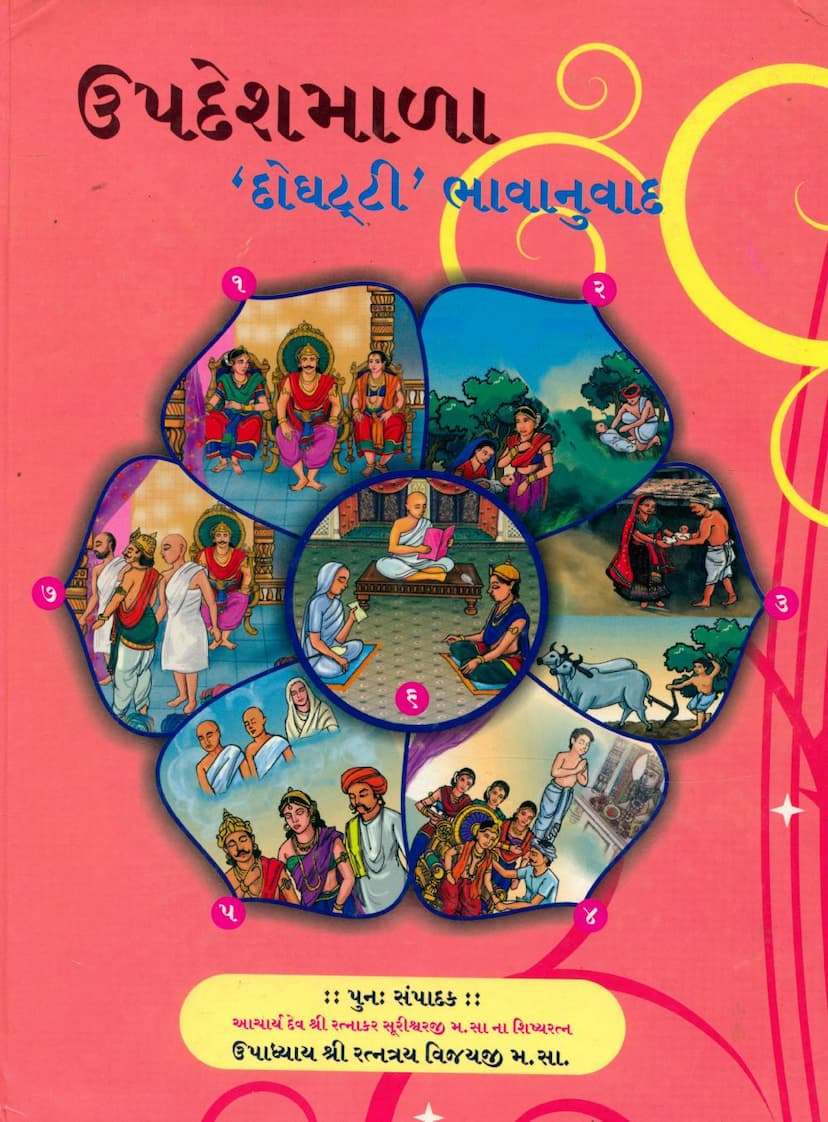Updeshmala Doghatti Bhavanuvad
Added to library: September 2, 2025

Summary
This Jain text, Updeshmala Doghatti Bhavanuvad, authored by Ratnatrayvijay and published by Ranjanvijay Jain Pustakalay, is a Gujarati translation and commentary of the Updeshmala, a work originally composed by Dharmadasagani. The catalog link provided is for Jainqq.org.
The text is a significant Jain scripture containing sermons and moral teachings, often illustrated with numerous stories and narratives. Here's a comprehensive summary based on the provided pages:
Core Purpose and Origin:
- Updeshmala: The original Updeshmala (also transliterated as Uvadeshamala) was composed by the revered Jain Acharya Dharmadasagani during the fifth era of the Avasarpini (the descending cycle of time). It consists of 542 Prakrit verses.
- Motivation: Dharmadasagani wrote this text to guide his own son, Prince Ransingh, who was a royal prince, towards spiritual understanding and detachment. It also aimed to serve as a guide for others.
- Transmission: The verses were memorized by Vijay Sadhvi and Sujaysadhu (also known as Jinasagani) and then conveyed to Prince Ransingh. Prince Ransingh himself memorized these verses, attained detachment, and passed the scripture on to his son along with the kingdom, before taking vows of renunciation.
- Commentary (Doghatti Bhavanuvad): The title indicates it is a "Doghatti Bhavanuvad," meaning a translation and commentary (Vagvad) of the "Ghatti" (likely referring to a commentary) with a focus on "Bhavan" (meaning/essence). The specific commentary referred to is by Ratnaprabhasuri, a disciple of Vadideva Suri. This edition is re-edited by Acharya Dev Shri Ratnakar Surishwarji's disciple, Upadhyay Shri Ratnatrayvijayji. The translation into Gujarati is attributed to Acharyadev Shri Hemasagarsurishwarji, a disciple of Acharyadev Shri Anandasagarsurishwarji.
Content and Significance:
- Moral and Spiritual Guidance: The Updeshmala is considered a vital scripture for the Jain sangha (monks, nuns, laymen, and laywomen). It aims to help souls navigate the cycle of birth and death (samsara) and progress on the path to liberation (moksha) by cultivating right faith (samyak-darshan), right knowledge (samyak-gyan), and right conduct (samyak-charitra).
- Vairagya-Uttpadak Shastra: It's described as a "Vairagya-utpadak Shastra" – a scripture that generates detachment from worldly affairs.
- Rich with Stories: The text is filled with numerous beautiful illustrative stories (katha) – over 500 according to the preface – which make the teachings accessible and engaging. These stories are valuable for both monks and lay followers.
- Accessibility: This particular edition is re-published with a "Doghatti Tikawala" (commentary with two layers of explanation) in simple Gujarati, making it more accessible to the Gujarati-speaking readership.
- Timeliness: The preface highlights that such profound texts are crucial for souls who are heavily burdened by karma, prone to negligence, deeply attached to worldly desires (artha, kama), and lack enthusiasm for virtuous actions (samyam, tapas). Reading Updeshmala can help such souls become travelers on the path of Dharma and Moksha.
- Historical Context: The text references influential Jain scholars and Acharyas like Shrutdhar Prabhavaak Sthavirebhyo, Bhadrabahuswami, Shyyambhava Suri, Jinbhadra Gani Kshamashraman, Haribhadra Suri, Abhaydev Suri, Hemchandracharya, and many others, emphasizing the rich intellectual tradition within Jainism.
- Specific Teachings/Themes:
- Vairagya (Detachment): The stories and teachings aim to foster detachment from worldly pleasures and attachments.
- Vinay (Humility and Respect): The importance of respecting elders, teachers (gurus), and following their teachings is emphasized.
- Karma and Its Consequences: The text implicitly or explicitly discusses the results of actions (karma) and their impact on one's spiritual journey.
- The Path to Moksha: The ultimate goal is liberation, achieved through right faith, knowledge, and conduct, which are facilitated by the teachings of the Updeshmala.
- The Influence of Kaliyuga: The text discusses the impact of the current era (Kaliyuga) on societal and spiritual life.
- The Power of Tapasya (Austerity): The stories of Rishabhdeva and Mahavir Bhagwan are used to illustrate the efficacy of tapasya.
Key Commentaries and Translators Mentioned:
- Original Author: Dharmadasagani
- Early Commentator: Udayadharma Gani (Vossayamulananam no. 51, circa VS 1905).
- Famous Sanskrit Commentary: Siddharshi (around VS 962), renowned as Vyakhyatachudamani.
- Prakrit/Apabhramsha Commentary ("Doghatti"): Ratnaprabhasuri (VS 1238), based on Siddharshi's commentary, containing narratives.
- Gujarati Translation: Acharyadev Shri Hemasagarsurishwarji.
- Sanskrit Introduction (Upakram): Muni Shri Abhayasagarji (disciple of Muni Shri Dharmasagarji, disciple of Acharya Shri Chandrasagarsuriji).
- Re-editor: Upadhyay Shri Ratnatrayvijayji.
Notable Stories and Figures Mentioned in the Table of Contents (Pages 10-16):
The extensive table of contents reveals the breadth of stories and teachings, including:
- Lives of Tirthankaras (Rishabhdev, Mahavir, Bahubali, Jambuswami).
- Stories of various monks and nuns (Chandanbala, Sagaradatta Muni, etc.).
- Tales of Kings and Queens (Bharat Maharaja, Pradyot Raja, Shrenik, Konik, etc.).
- Illustrative examples on virtues like forgiveness, humility, righteousness, detachment, greed, etc.
- Discussions on Jain philosophy, ethics, and practices.
Overall Impression:
Updeshmala Doghatti Bhavanuvad appears to be a comprehensive and accessible rendition of a foundational Jain text, rich in narrative and aiming to provide practical spiritual guidance for adherents. The re-editing and translation aim to make this ancient wisdom relevant and understandable to modern Gujarati readers. The text emphasizes the importance of moral conduct, detachment, and spiritual discipline for achieving liberation, drawing upon a vast repository of stories from Jain tradition.